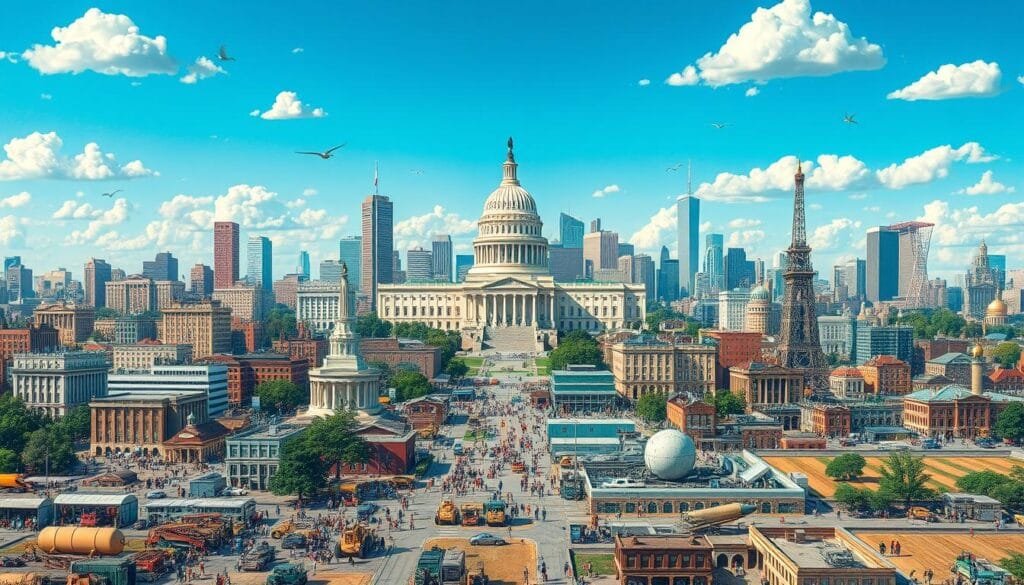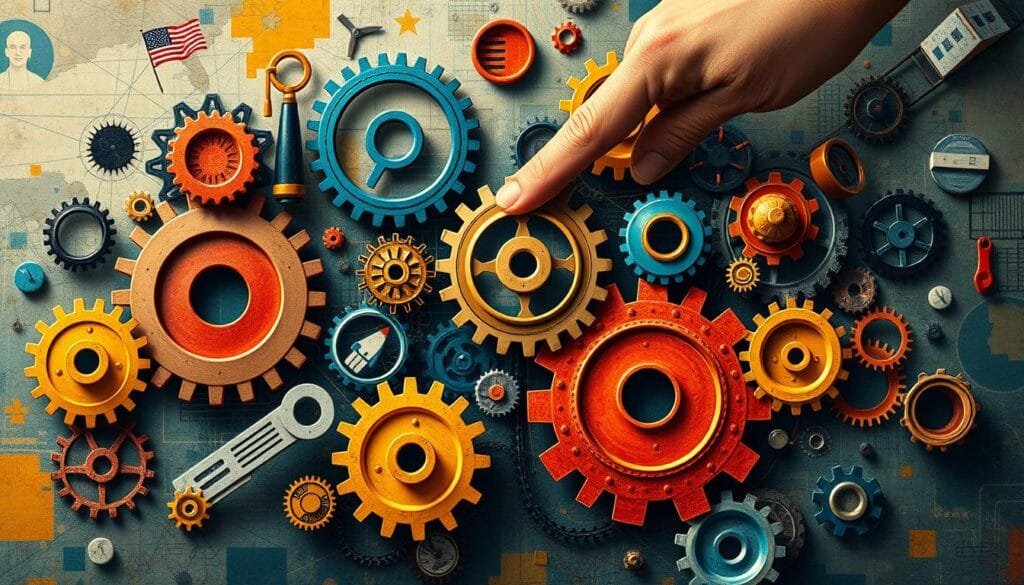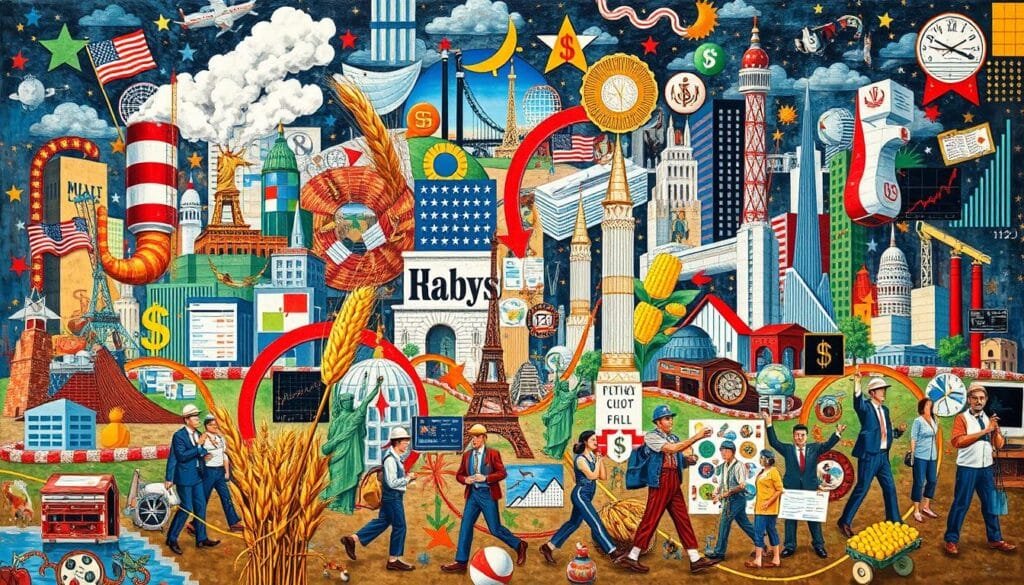Exploring the American economic history reveals its unique stance. The U.S. mixes classic capitalism with smart rules, creating a dynamic mixed economy. This balance plays a big part in its global economic role.
In 2021, the U.S. economy grew by 6.6% in just the first three months. This was after a 3.5% drop in 2020. This shows the power of a flexible economy, something quite special globally.
We’re looking into how combining free-market principles with strategic planning has made the U.S. a symbol of economic leadership. It’s all about finding the right mix for growth and stability.
Key Takeaways
- The U.S. maintains its status as the largest economy globally by nominal GDP.
- It exhibits a mixed economy with characteristics of both command and market systems.
- The adaptability of the U.S. economic system allowed for a robust recovery post 2020’s decline.
- American economic policies and mechanisms have a significant ripple effect on the global economy.
- A majority of the nations have evolved to assimilate facets of various economic systems into their own.
- The success stories of American firms like McDonald’s in China reflect the global influence of U.S. capitalism.
Exploring the Basics of the U.S. Economic System
At the heart of the United States is a economic foundation made strong by different elements and ideas. We see economic expansion because of a hard-working labor force, innovative entrepreneurs, and a big push towards free enterprise.
The American economy is built on capitalism. Here, private companies and individual freedoms shape our economic world. This approach lets the U.S. adapt and lead in the global market.
The Foundation and Evolution
The U.S. economy started with agriculture and grew into a leader in industry and tech. A mix of rich natural resources and a diverse labor force drives our economic expansion.
Capitalism and Its Nuanced Application
The U.S. type of capitalism loves free enterprise. Yet, combining private ownership with government intervention has been key. It creates a good environment for businesses to grow.
Mixed Economy: The Modern Reality
Now, the U.S. has a mixed economy. It blends market freedom with government intervention. This mix comes from economic policies aiming to keep the economy stable. Both the government and the private sector manage the economy. This helps balance wealth and poverty and protect against downturns.
The table below shows key facts about the U.S. economy:
| Indicator | 2023 | 2024 | Description |
|---|---|---|---|
| GDP (Trillion USD) | 28.467 | 29.167 | Nominal value of all goods and services |
| Unemployment Rate (%) | 4.0 | 4.2 | Percentage of the labor force that is jobless |
| Inflation Rate (%) | 3.0 | 2.4 | General increase in prices and fall in the purchasing value of money |
| Labor Force | 160,000,000 | 161,200,000 | Number of people available for work |
This blending of ideas and practices has let the U.S. develop a strong and growing economy. Smart government intervention and good economic policies support our economic foundation.
What is the economic system in the U.S.
The U.S. showcases a mixed economy. This means it blends market freedom with government control. This approach helps balance private and public interests. It leads to economic growth and helps everyone in society.
In this system, businesses can compete and innovate freely. This is thanks to the market economy aspect. But, the government steps in areas like healthcare and education. This ensures the market’s downsides are checked.
The government wears many hats. It ensures fair play in business and looks after the public’s well-being. It uses policies to keep the economy growing at a healthy pace. Also, it steps in during economic ups and downs to keep things stable.
At heart, the U.S. economic system aims for freedom with responsibility. It’s about finding the right mix between enterprise and social care. The Federal Reserve plays a big part in maintaining this balance through policy and oversight.
| Economic Indicator | 2023 Stat | 2024 Projected |
|---|---|---|
| GDP Growth Rate | 2.9% | 2.8% |
| Inflation Rate | 2.3% | 2.4% |
| Unemployment Rate | 4.1% | 4.2% |
| Population | 338.7 million | 341.1 million |
| Federal Debt as % of GDP | 120% | 121% |

Government’s Role in the U.S. Economy
The U.S. government deeply affects our economy through its regulations and fiscal policies. It decides how to spend public funds and guides the overall economic path. This role includes many layers of oversight and help.
Regulatory Functions and Economic Interventions
In the past, the government played a small role in the economy. But today, it has a major oversight role. This change started because the rapid growth of industries led to problems. For instance, the Sherman Antitrust Act of 1890 was created to stop companies from controlling entire industries. Over time, the government began to oversee more areas like food safety, education, and healthcare. These areas now have wide support from the public.

Federal Reserve and Monetary Policy
The Federal Reserve is key in managing the country’s economy. It controls monetary policy to keep prices stable and support the financial system. Created in 1913, it adjusts interest rates and the money supply. These moves affect how much people borrow and lend, helping to manage economic downturns and boost recovery. This was especially clear during the crises in 2008 and 2020.
Fiscal Policy: Budgeting and Government Spending
Government budgeting and spending influence our economic landscape. Fiscal policy, through managing government expenditure, supports vital areas. These include infrastructure, defense, and social services. Government decisions have big effects on the nation’s economic health and growth. They impact public jobs and how much the country produces.
As we face new challenges like digital currencies and the gig economy, the government’s economic role is expected to increase. We will need ongoing changes in how we regulate and spend. This is essential for maintaining our nation’s economic wellbeing and competitiveness on the world stage.
Key Components Driving the U.S. Economy
The U.S. economy is strong because of high-tech industries, new practices, and a vital service sector. These elements work together, using our natural resources and labor productivity. Our economy grows when different areas work well together, helped by how people spend their money.
Natural Resources and Labor Force
The U.S. has many natural resources that help our economy. Our skilled workers also play a big role in our success. Not only do these resources include farming, but also valuable minerals and being a leader in energy.
Workers are getting better through education and tech, meeting the economy’s needs.
Innovation and Technological Advancements
Innovation drives our economy, especially in high-tech industries. The U.S. is good at creating new things which help various sectors. This creativity helps our economy and makes us a world leader in new technologies.
Consumer Spending and the Service Sector
People spending money is a big part of the U.S. economy. Most of our GDP comes from the service sector. This change shows how our buying habits are changing and growing parts like healthcare and digital services. This is helped by strong spending that affects our daily lives and how we enjoy them.

| Year | Nominal GDP (Billion USD) | GDP Per Capita (USD) | Service Sector Contribution (%) |
|---|---|---|---|
| 2022 | 25,744 | 82,715 | 81 |
| 2023 | 27,721 | 77,187 | Estimated to grow |
This synergy of natural resources, worker skills, innovation, and spending keeps the U.S. economy growing.
Conclusion
As we look at the U.S. economy, we learn more about what makes it successful and influential worldwide. The U.S. stands out for its economic growth after the pandemic and low joblessness, showing a strong work force. This strong recovery is thanks to a system that knows how to get its energy back. This happens through big public projects in tough times and adopting new tech changes.
The U.S. economy’s skill to adapt is linked to its history of government help and innovation driven by the market. It’s a story of changing from the days of promoting national unity through economy to today’s tech and global trade network. Our economy has moved from farming to industry, has started huge projects to connect the country, and has adapted to globalization, letting us reach the worldwide market from our screens. The steady core inflation rate shows how our economy manages growth and stability.
The role of social contributions in economic growth is very important. Laws for work standards and embracing immigrants have helped shape our economy. Thinking about the U.S. economy, it’s clear its strength is not just about numbers. Our economic strength comes from our shared commitment to doing well together, balancing freedom and thoughtful planning. This balance is key to our global impact, mixing lessons from the past, current innovations, and future goals, always moving toward wealth.
FAQ
What defines the economic system in the U.S.?
The U.S. has a mixed economy. It combines market freedom from capitalism with socialism’s government rules. This mix helps keep the economy stable and supports the community.
How has American economic history shaped the current system?
The U.S. economy grew from simple startups to big industries. This growth was helped by diverse workers and smart use of natural resources. It created a strong mixed economy.
What is the role of capitalism in the U.S. economy?
Capitalism in the U.S. means owning private property and running businesses freely. But it’s adjusted with rules to fix societal issues and avoid too much power in few hands. This way, it fits American values.
In what ways does the government intervene in the U.S. economy?
The government steps in by setting rules, changing the economy, and using money wisely. It makes things safe and fair, controls money flow, and provides public services. This helps keep the market fair for everyone.
How do natural resources and labor force contribute to the U.S. economy?
Valuable natural resources and a working climate boost industries like farming and energy. The workforce grows with immigration and a focus on skills. This boosts productivity and economic growth.
What is the significance of innovation and technology in the American economy?
New ideas and tech push the U.S. economy forward, especially in advanced industries. Flexible business models help spark creativity and stay competitive. This is key for economic success.
Why is the U.S. considered a “consumer economy”?
The U.S. focuses on buying goods and services, making up a big part of its economy. The service industry meets this consumer demand, shifting from making goods to providing services. This shift fuels economic growth.
How does the mixed economy model benefit the U.S. on a global scale?
The mixed economy allows the U.S. to enjoy capitalism’s freedom with important government controls. This leads to a high quality of life and strong economic position worldwide.
